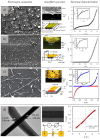New Insights to Design Electrospun Fibers with Tunable Electrical Conductive-Semiconductive Properties
- PMID: 36772646
- PMCID: PMC9919353
- DOI: 10.3390/s23031606
New Insights to Design Electrospun Fibers with Tunable Electrical Conductive-Semiconductive Properties
Abstract
Fiber electronics, such as those produced by the electrospinning technique, have an extensive range of applications including electrode surfaces for batteries and sensors, energy storage, electromagnetic interference shielding, antistatic coatings, catalysts, drug delivery, tissue engineering, and smart textiles. New composite materials and blends from conductive-semiconductive polymers (C-SPs) offer high surface area-to-volume ratios with electrical tunability, making them suitable for use in fields including electronics, biofiltration, tissue engineering, biosensors, and "green polymers". These materials and structures show great potential for embedded-electronics tissue engineering, active drug delivery, and smart biosensing due to their electronic transport behavior and mechanical flexibility with effective biocompatibility. Doping, processing methods, and morphologies can significantly impact the properties and performance of C-SPs and their composites. This review provides an overview of the current literature on the processing of C-SPs as nanomaterials and nanofibrous structures, mainly emphasizing the electroactive properties that make these structures suitable for various applications.
Keywords: biointegration; conducting polymers; conductive fiber-based structures; electrospinning; fiber electronics; semiconducting polymers.
Conflict of interest statement
The authors declare no conflict of interest.
Figures










References
-
- Serrano-Garcia W., Jayathilaka W.A.D.M., Chinnappan A., Tran T.Q., Baskar C., Thomas S.W., Ramakrishna S. Nanocomposites for electronic applications that can be embedded for textiles and wearables. Sci. China Technol. Sci. 2019;62:895–902. doi: 10.1007/s11431-018-9436-6. - DOI
-
- Li C., Qiu M., Li R., Li X., Wang M., He J., Lin G., Xiao L., Qian Q., Chen Q., et al. Electrospinning Engineering Enables High-Performance Sodium-Ion Batteries. Adv. Fiber Mater. 2022;4:43–65. doi: 10.1007/s42765-021-00088-6. - DOI
-
- Wang Y., Liu Y., Liu Y., Shen Q., Chen C., Qiu F., Li P., Jiao L., Qu X. Recent advances in electrospun electrode materials for sodium-ion batteries. J. Energy Chem. 2021;54:225–241. doi: 10.1016/j.jechem.2020.05.065. - DOI
-
- Liang J., Zhao H., Yue L., Fan G., Li T., Lu S., Chen G., Gao S., Asiri A.M., Sun X. Recent advances in electrospun nanofibers for supercapacitors. J. Mater. Chem. A. 2020;8:16747–16789. doi: 10.1039/D0TA05100D. - DOI
Publication types
Grants and funding
LinkOut - more resources
Full Text Sources

